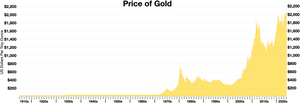1970s commodities boom

The 1970s commodities boom refers to the rise of many commodity prices in the 1970s. Excess demand was created with money supply increasing too much and supply shocks that came from Arab–Israeli conflict, initially between Israel and Egypt. The Six-Day War where Israel captured and occupied the Sinai Peninsula for 15 years, the Closure of the Suez Canal (1967–1975) for 8 years of that, lead to supply shocks. 66% of oil consumed by Europe at that time came through the Suez Canal and had to be redirected around the continent of Africa.[1] 15% of all maritime trade passed through the Suez Canal in 1966, the year before it closed.[2]
The Yom Kippur War in late 1973 was Egypts attempt at crossing the Suez Canal and taking the Sinai Peninsula back from Israeli occupation. On October 19, 1973 Richard Nixon requested $2.2 billion to support Israel in the Yom Kippur War. That resulted in OAPEC countries cutting production of oil and placing an embargo on oil exports to the United States and other countries backing Israel. That was the start of the 1973 oil crisis.[4]
Food commodities


In the early 1970s, the Soviet Union and many other planned economies started importing large amounts of grains in the global markets, driving up demand for grains and oilseeds. [5]
Sugar
Sugar prices spiked in the 1970s because of Soviet Union demand/hoarding and possible futures contracts market manipulation. The Soviet Union was the largest producer of sugar at the time. In 1974, Coca-Cola switched over to high-fructose corn syrup because of the elevated prices.[6][7]

Coffee
The price of coffee went up in the mid 1970s because of a black frost of 1975 that killed 66% of Brazil's coffee trees, which was the number one producer of coffee at the time. There was a big earthquake in 1976 in Guatemala that disrupted supply chains, the world's fifth biggest coffee exporter at the time. The Angolan Civil War started in 1975 disrupting their coffee production and shipping.[8]

Gold
The United States weaned itself off the gold standard in the 1970s, allowing the price of gold to float. The price of gold went from a set exchange rate of $42.22 per troy ounce in 1973 to almost $200 per ounce in 1976.[9]

Copper

Price controls were implemented in the early 1970s to combat inflation but when those price controls were lifted on commodities like copper the prices appreciated. These quick price rises were known as the Nixon shock.[10][11]
Coal

Coal price increases in the 1970s were primarily demand driven. There was a strike by the United Mine Workers of America called The Brookside Strike in late 1974 that lasted for 3 weeks but was said to have little impact on prices.[12]
Floating exchange rates and commodities

After World War II the Bretton Woods system had fixed exchange rates between countries and pegged to gold. This kept some commodities like gold very stable. When the Bretton Woods system failed in the early 1970s and floating exchange rates started to float, commodities also became very volatile.[13][10]
See also
- 1976 sterling crisis
- 2000s commodities boom
- 2020s commodities boom
- List of commodity booms
- Petrocurrency
- Stagflation
- U.S. Dollar Index
- Winter of Discontent
References
- ^ "Suez Crisis".
- ^ "Choked off: The Six Day War's Impact on Maritime Trade".
- ^ "Crude Oil Prices - 70 Year Historical Chart".
- ^ Corbett, Michael. "Oil Shock of 1973–74". Federal Reserve History. Retrieved 2022-08-27.
- ^ "USDA ERS - Agricultural Commodity Price Spikes in the 1970s and 1990s: Valuable Lessons for Today".
- ^ "A History of Sugar Prices".
- ^ Ennis, Thomas W. (5 January 1972). "Sugar Futures up on Soviet Buying". The New York Times.
- ^ Maidenberg, H. J. (12 February 1976). "Higher Coffee Prices Are Expected". The New York Times.
- ^ Elwell, Craig K. (23 June 2011). "Brief History of the Gold Standard in the United States" (PDF). Congressional Research Service.
- ^ a b Cooper, Richard N.; Lawrence, Robert Z. (1975). "The 1972–75 Commodity Boom" (PDF). Brookings Papers on Economic Activity. 3: 671–723. doi:10.2307/2534151. JSTOR 2534151.
- ^ "A History of Copper Prices".
- ^ "Study of coal prices. [USA; 1948 to 1969; 1969 to 1974]". March 1976. OSTI 5516263.
- ^ "About the IMF: History: The end of the Bretton Woods System (1972–81)".
- https://www.brookings.edu/wp-content/uploads/1975/12/1975c_bpea_cooper_lawrence_bosworth_houthakker.pdf